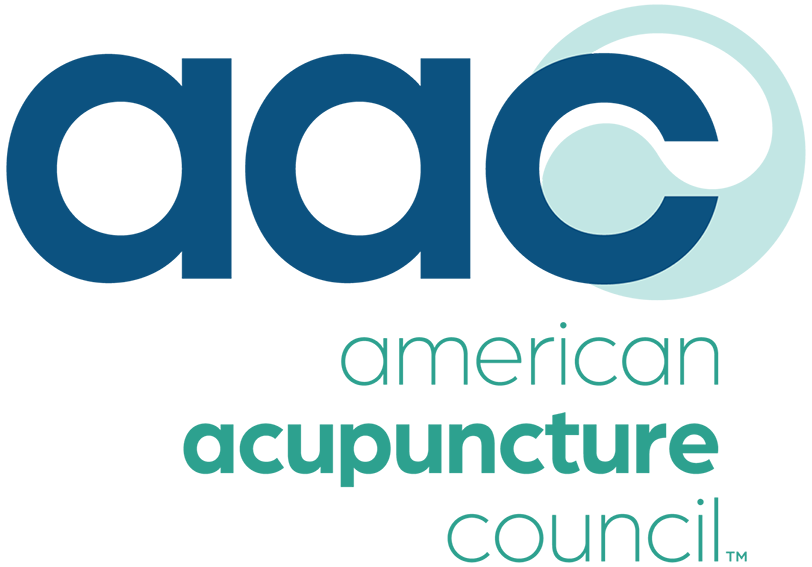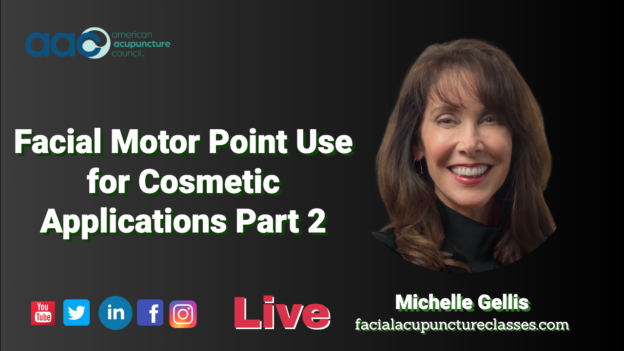Today’s talk focuses on facial motor points. Last time, if you missed part one, I talked about using facial motor points for cosmetic applications. And today we are gonna be talking about so cosmetic applications like, Crow’s feet or frown lines.
Click here to download the transcript.
Disclaimer: The following is an actual transcript. We do our best to make sure the transcript is as accurate as possible, however, it may contain spelling or grammatical errors. Due to the unique language of acupuncture, there will be errors, so we suggest you watch the video while reading the transcript.
Hi, my name is Michelle Gellis and I am an acupuncture physician who teaches facial acupuncture classes internationally. Today, I will be presenting part. Two of a lecture on using facial motor points for facial concerns, and if you would please go to the first slide.
Click here for the best Acupuncture Malpractice Insurance
This is a list of the different classes that I teach. They are all recorded and on my website, and today we will be going over some of the. Topics that I cover in treating neuromuscular facial conditions and some of the advanced techniques from my facial acupuncture class.
Today’s talk focuses on facial motor points. Last time, if you missed part one, I talked about using facial motor points for cosmetic applications. And today we are gonna be talking about so cosmetic applications like, Crow’s feet or frown lines. But today I am going to be talking about using facial motor points for a couple of different types of neuromuscular facial conditions, and the two that I’m going to discuss today are Bell’s Palsy and Ptosis.
Get a Quick Quote and See What You Can Save
But first I wanna review quickly. What is a motor point? If a muscle. Is not functioning properly. Using an acupuncture needle and putting it into the motor point of the muscle is like a reset switch and it will bring the muscle back into normal functioning. Because on our face, the skin is attached to the muscle.
Using the motor points on the face can help the face to not only look, differently getting rid of tension and wrinkles and lines and folds, but it can also help the face to function properly so that if someone has some sort of a neuromuscular facial condition, using the motor point can help to resolve that.
A motor point is different than a trigger point. A trigger point is like a knot in a muscle, whereas a motor point is, so if this is your peripheral nerve, you have your sensory nerve, and then you have your motor nerve, and the motor point is where the motor. Attaches into the muscle. It is the most electrically excitable part of the muscle where the motor nerve is attached.
The face has two nerve branches that are in charge of the functioning and the sensory of the face. So we have the trigeminal nerve, which is. The fifth facial nerve CN five, and that takes care of sensation. And also mastication, it connects to your massacre, the facial nerve which is CN seven, cranial nerve seven.
Helps the functioning of the face, so your facial expressions and also taste. So you can see the two different nerves. We have the facial nerve and the trigeminal nerve. And the trigeminal nerve has the ophthalmic branch, the maxillary branch, and the mandibular branch, and the facial nerve has five.
Branches, the temporal zygomatic, bcal, the mandibular branch, and then the cervical branches which go down to the platysma.
The first neuromuscular condition we’re going to talk about is Bell’s Palsy and. Be’s palsy is the most common cause of facial paralysis that you will find in your treatment room, that you’ll see in your treatment room typically, and it’s a disruption of the facial nerves, and it can result in facial paralysis, weakness, drooping, inability to keep the eyelid open or closed.
You can patients can get unusual taste sensations, hearing loss, ear pain and normally the symptoms get at their peak within 48 hours and can last for several weeks up through a lifetime.
Palsy is typically in Western medicine. It’s typically thought of as a result of a virus and, mostly it is seen in individuals between the ages of 15 and 60, although I have seen patients as young as two in my treatment room with Bell’s Palsy, and it usually follows some sort of a viral infection.
It is seen. In a very large number of pregnant women and Western medicine treats it with drugs such as Acyclovir. And also usually so the acyclovir is an antiviral, and then frequently they will give some sort of a steroid to help with any inflammation. So the first thing you would do is an exam protocol, and in order to ascertain which of the muscles is not.
Functioning properly. So you would look at, for example, the frontals. The way you would determine if that is working properly is you’d have your patient raise their eyebrows, close their eyes, and you’re going to be looking for any disparity between the two eyes. Have them smile, and this is going to let you know how the zygomaticus major and minor.
Functioning the orbicularis, orus, the lator muscles, and ZOS. Et cetera, et cetera. So you’re gonna go through the exam of the different facial muscles and you’re going to look for any disparity, and then you will know which muscles to treat, and then within that muscle group. Where the different motor points are, and fortunately for us, the motor points on the face, most of them are either on an acupuncture point or they’re right between a couple of acupuncture points.
So it makes it easier for us to find them because the muscle, the face does have a lot of muscles.
So the first motor point that we would use if someone could not pull their eyebrows together and frown would be the motor point for the corrugator muscle, which is just lateral to bladder two.
The next, as I mentioned the frontals that raises the eyebrows and the motor point for that is gallbladder 14. So you would treat the affected side for the orbicularis oculi. This can help with. Closing the eyelids, and that can sometimes be a problem. People with Bell’s Palsy, they have to take their eyelids shut and the motor points.
There’s two for each eye, and one is between Sania 23 and gallbladder one, and then the other is the extra point Q Hoag, which is right on the orbital Ri. It’s between stomach two and gallbladder one. The next is the motor point for the Zygomaticus major, and that is SI 18, and you’re going to needle into the muscle, but not through the muscle.
The Zygomaticus minor helps to elevate the lip and the motor point for that is between stomach two and stomach three. For the levator Labii Superioris, the motor point is between LI 20 and stomach two, and the levator labii Superioris helps to elevate the lip individually as if snarling the Tallis, is on either side of Ren 24 and it is a half soon lateral to Ren 24, and this helps to elevate and protrude the lower lip.
So in addition to ascertaining which muscles you’re going to treat. If you were treating a condition such as Bell’s Palsy, you also would want to do a full body treatment. And so you would do your TCM diagnosis and look for the pattern and treat the underlying pattern. In the case of Bell’s Palsy, it is either blood stagnation, a lung wind invasion, or a spleen chi deficiency.
And then you would do local points and motor points on the face where the person has the deficiency. In addition to any body points, posis is another neuromuscular facial condition that. You will see commonly in your treatment room, and it can affect one eye or both eyes. It’s when the eye lids are not opening fully.
Everyone has a little bit of ptosis, but it can happen as we age. Some people are born that way and for others it can happen after some sort of an injury or even an illness. And this these are different levels of ptosis. This is slight ptosis, very slight ptosis. And this is due to aging. And then this is more severe ptosis.
I already went through all of this. There are many different causes of ptosis again people, sometimes people get ptosis when they have cluster headaches and, some sort of brain injury as I mentioned injury. A brain injury, spinal cord injury can cause ptosis as well. The motor points that you would use ver posis are the orbicularis oi, and also the frontalis can help the major muscle that’s involved.
Is the levator muscle, but there is no motor point for that. There is a way to treat it with cosmetic threading techniques, but I cover that in my cosmetic classes. When you’re looking at posis of the upper eyelid, it’s either a deficiency of spleen. And kidney or and or spleen deficiency with wind phlegm or oh, I’m sorry.
Let me back up a step. The slide is confusing. The it’s either a spleen deficiency with wind phlegm. Or a deficiency of spleen and kidney. And so the, you would do your differential diagnosis based on what the symptoms are, and then you would treat the underlying symptoms accordingly, as well as using the motor points.
This is information on how to find me if you are interested in. More information. You can follow me on Instagram or join my Facebook group, facial Acupuncture and my website for all of my recorded and live classes I do teach internationally is facial acupuncture classes.com.
I wanted to say thank you for today for coming, and thank you to the American Acupuncture Council for giving me this opportunity to spend some time teaching you.






